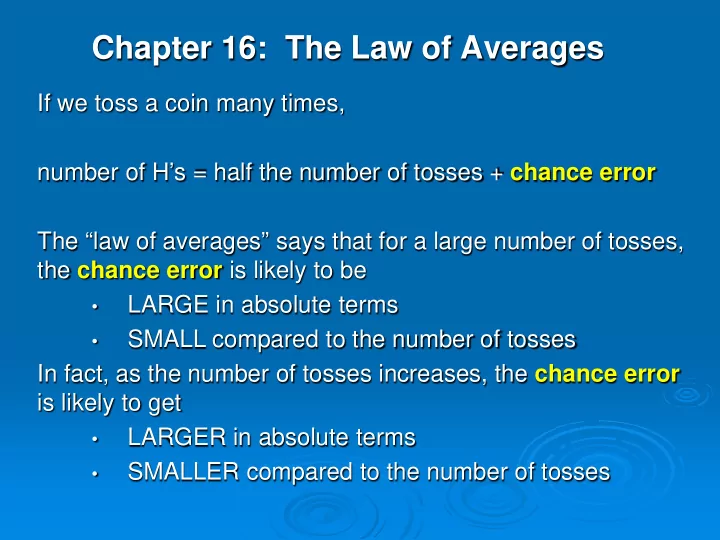

Chapter 16: The Law of Averages If we toss a coin many times, number of H’s = half the number of tosses + chance error The “law of averages” says that for a large number of tosses, the chance error is likely to be LARGE in absolute terms • SMALL compared to the number of tosses • In fact, as the number of tosses increases, the chance error is likely to get LARGER in absolute terms • SMALLER compared to the number of tosses •
In terms of percentages, the “law of averages” says that as the number of tosses increases, the percentage of H’s is likely to get closer and closer to 50%, but it is less and less likely to be exactly 50%. In fact, as the number of tosses increases, the percentage error is likely to get smaller and smaller.
Example 1. A coin will be tossed and you win $1 if the number of heads is exactly equal to the number of tails. Which is better for you, 10 tosses or 1000?
Example 2. A coin will be tossed and you win $1 if the percentage of heads is between 40% and 60%. Which is better for you, 100 tosses or 1000?
Example 3. You are betting on tosses of a coin: if the coin lands heads, you win $1, if it lands tails, you lose $1. The last 10 tosses have all been heads. What’s the chance the next toss is a head?
Example 4. You play a game in which you win $1 if the percentage of heads is 60% or more. Which is better for you, 100 tosses or 1000 tosses?
Example 5. You play a game in which a die is rolled and you win $1 if the percentage of “6”s is 20% or more. Which is better for you, 100 rolls or 1000 rolls?
Chance Processes Chance processes are ones that are affected by chance error. Examples: • number of H’s when tossing a coin • amount of money won when playing a game of chance • percentage of Democrats in a random sample of people Box models help us to answer the question: “ how large is the chance error likely to be?”
Box Models Box models make an analogy between a chance process and drawing tickets from a box. Usually, the analogy goes like this: The quantity of interest is like the ____?____ of ___?___ draws from the box: … ? ? ?
Box Models To make a box model, answer the following questions: • What is the quantity of interest? Are we interested in the sum of the draws the average of the draws? the percentage of 1’s in the draws? • How many draws? • How many tickets go in the box? • What numbers go on the tickets?
Example 6. You play a game in which you roll a die 10 times and get paid the amount shown on the die (each time). Find a box model for the total amount you win .
Example 7. You play a game in which you roll a die 10 times. Each time a “6” occurs, you win $10, otherwise you lose $1. Find a box model for the total amount you win .
Example 8. A multiple-choice test has 20 questions, each with 4 possible choices. Each correct answer is worth 5 points, and for each incorrect answer you lose 2 points. Find a box model for your test score if you guess all the answers.
Recommend
More recommend